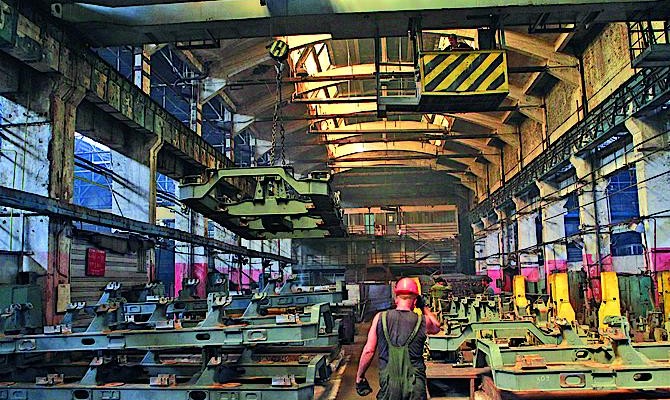Economy
prospectsMechanical engineering sector collapsed by almost 20% in H1 2014. In the second half of the year the situation will not improve

Ukrainian mechanical engineering continues to lose its ground. Based on data from the State Statistics Service, in January – June another decline in production in this industry of 18% was observed compared to the same period in 2013. Russia, the main foreign consumer of products manufactured by Ukraine’s mechanical engineering sector, is responsible for the current situation.
Russian influence
The more products Ukrainian companies supply to Russia, the more painful for them is the policy of reduction of purchases of Ukrainian products by Russia, says senior analyst at ART Capital Oleksiy Andriychenko. Statistics show that the largest decline in output was registered in transport engineering (-32.5%). This particularly concerns the production of railway transport (-55.3%). For example, in 2013 Russia received 71% of the total exports from Ukraine for its railways. The dynamics of decrease in the production of freight cars is also impressive. According to the State Statistics Service, in the first half of 2014 the companies in this sub-sector produced a total of 3,500 railcars, while the capacity of car-building enterprises is close to 38,000 railcars per year.
“It is not about the restriction of imports and the increased tension in Ukrainian-Russian relations. Russia significantly reduces investments into infrastructure projects that involve the acquisition of Ukrainian machine-building products,” says Deputy Director of the Ukrpromzovnishekspertyza state enterprise Serhiy Povazhnyuk.
Specifically, he said this year the Russian Railways company has cut its investment program by 16% - from 467 bn rubles to 392 bn rubles. Factoring in the 10% devaluation of the ruble against the dollar, the cut in the investment program will seem more significant. This will affect the procurement of locomotives from Ukraine’s LuhanskTeplovoz. The Russian market of freight cars is also saturated, which dramatically reduces the demand for products of Ukrainian car-building industry: Kryukivskiy and Stakhanivskiy Railway Car Building Works, Dniprovahonmash and Azovmash. The Federal Grid Company (operator of Russian electrical power networks) – buyer of transformers from Zaporizhtransformator – cut its investment program, approved last year for 2014 – 2019, by 43% from 620 bn rubles to 354 bn rubles.
The Sumy-based Frunze Machine-Building Science and Production Association has also suffered from the decrease in orders. Representative of the association says that in the current conditions the main task for the company’s management is filling the vacuum in orders portfolio. Russia has reduced the volume of orders from 65% to 15% in 2014, which resulted in a loss of US $350 mn. “We are systematically moving into new markets. The company has already received pre-qualification of a supplier of goods and services in such countries as Saudi Arabia, Indonesia, Iraq, Thailand and Qatar. It is going through a similar procedure in Malaysia. We are also in talks for cooperation with Poland, Turkey, Brazil and other countries. Moreover, we certify our products for compliance with standards effective not only in Europe but all over the world,” says the company’s CEO Oleksiy Tsymbal.
Survivors
Noteworthy, two areas of mechanical engineering managed to resist the decline and even increased their performance only because they depended on exports to Russia less than other sub-sectors. In 2013 Russia’s share in Ukrainian exports of electrical equipment was only 35%. The relatively low dependence on exports to this country has allowed this segment to show an 11.7% growth in January – June of 2014.
There are positive dynamics in the production of equipment for the metallurgy industry. This segment showed an increase of 6% in the first half of the year thanks to diversification of geography of sales, says Andriychenko. For example, based on results of the first five months of 2014 the total volume export was preserved in production of rolling mills and rolled steel, despite that the share of exports to Russia dropped during this period from 66% to 47%. Enterprises from this sub-sector have increased deliveries of their products to Italy.
Motor Sich, which managed to maintain supplies to Russia despite of all prohibitions, has shown relatively high performance indicators. The company has a stable demand, as Russian manufacturers are unable to organize the independent release of components, for which Motor Sich is currently responsible, in the near future. The situation is affected by the lack of production capacities and high technological efficiency of manufacturing processes, which requires more time to develop the technology and train personnel. “As a result, in dollar terms the company’s revenues in the first six months of the year fell by only 4% to US $455 mn. But at the same time its profits increased by 48% to US $149 mn. Devaluation of the hryvnia increased export revenues, but influenced the cost of production to a lesser degree,” said Andriychenko.
Positive dynamics were also observed at Turboatom. Its revenues in the first six months of the year increased by 7% to US $101 mn and its profits soared by 2.6 times to US $66 mn. Products of this company are strongly demanded by the domestic power generating plants. The share of Turboatom’s exports is 49%, so the impact of trade wars with Russia affects the company much less. In addition, the uniqueness of the manufacturer’s products reduces the risk of their substitution in the Russian market, experts say.
The share of supplies to Russia does not exceed 30% of exports at the Zorya - Mashproekt company in Mykolayiv (it produces power units for ships). This will help the company survive the decrease in deliveries to Russia due to the wide diversification of supplies, says Povazhnyuk.
Forecasts
Overall, during the second half of the year the performance indicators of machinery production will not change significantly, interviewed experts forecast. Although the rate of decline in 2014 compared to last year is likely to slow down due to the low base of comparison in the second half of 2013, stressed Andriychenko. He believes companies with low dependence on Russian market will remain afloat, as well as those whose competitive position is protected either by long-term contracts (such as Motor Sich) or high adaptability and uniqueness of products (such as Motor Sich, Zorya – Mashproekt and Turboatom).
In terms of tension in trade relations between Ukraine and Russia there is no need to expect much recovery in the automotive industry. The fact that tenders for the supply of freight cars for Ukrzaliznytsya, which will slightly support car builders, may take place by the end of the year, raises some hope. Although it will be impossible to replace those shipments that have traditionally accounted for Russia (80% of the manufactures car products) with domestic demand, analysts say.
At the end of the first six months of the year Ukraine’s automotive industry was hit by a serious crisis resulting from the decline in consumer demand due to the military operations, devaluation of the hryvnia and economic and political uncertainty. There is hope that by the end of the year the consumer demand will gradually recover as the conflict in the east is settled, political uncertainty subsides after the elections to the Verkhovna Rada and the economy in the country gradually comes back to normal. In any case, another significant collapse in car sales as the one observed at the peak of devaluation of the hryvnia in April – May is not to be expected in the near future, predicts Andriychenko.
Use the EU resource
Ukrainian mechanical engineering companies should take advantage of the free trade zone with the EU, believes Povazhnyuk. It will be difficult for producers to gain access to the European market as it requires investments into certification and improvement of product quality, says the expert. But at the same time it should be understood that the EU market is huge. And to gain entry Ukrainian manufactures need to cooperate with their European counterparts. “The experience of Turkey is quite telling. Almost from scratch, not having such manpower as Ukraine this country managed to increase the supplies of its engineering products from 2000 to 2007 by almost seven times – from US $4 bn to US $27 bn,” recalled the interlocutor with Capital.
There are examples of such cooperation in Ukraine – in particular, the joint venture with Czech Skoda for the production of electric locomotives. In 2005, the Antonov aircraft manufacturer planned to create a joint venture with Airbus, which would allow our company to enter the civil aviation market in Europe. The project was not implemented, but Ukraine may try to resume it. Ukraine must exploit the credibility of the EU in order to bring to fruition projects that will reduce the dependence of Ukrainian machine builders on supplies from Russia and make them more resilient on global markets.

Вот эффективность олигархической власти, которая сконцентрирована на пиаре и решение своих проблем, а не проблем страны. Если бы прислушались к антикризисной программе КПУ сейчас бы появлялись новые рабочие места и подъем экономики, а не то что мы наблюдаем.

Нет, главный виновник падения экономики - наша власть, которая руководствуясь указаниями МВФ, Штатов и ЕС принимает решения, вводит санкции, не думая о будущем страны. Россия запретила экспорт наших авто и куда их теперь продавать будем, в Америку, пусть они от своих Шевроле и Фордов откажутся и на наши Део сядут?! Но виноваты не только "демократы", а их предшественники, комми еще в 2011 году Антикризисную программу разработали и выступали с требованиями развивать высотехнологические и наукоемкие отрасли, чтобы наша продукция была конкурентоспособной.






 of the agreement of syndication with Financial Times Limited are strictly prohibited. Use of materials which refers to France-Presse, Reuters, Interfax-Ukraine, Ukrainian News, UNIAN agencies is strictly prohibited. Materials marked
of the agreement of syndication with Financial Times Limited are strictly prohibited. Use of materials which refers to France-Presse, Reuters, Interfax-Ukraine, Ukrainian News, UNIAN agencies is strictly prohibited. Materials marked  are published as advertisements.
are published as advertisements.